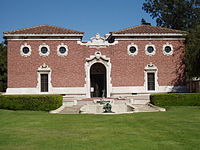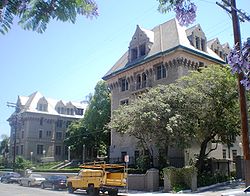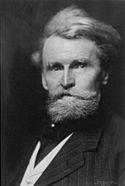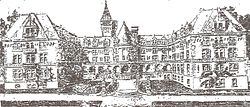- Mary Andrews Clark Memorial Home
-
Mary Andrews Clark Memorial HomeLos Angeles Historic-Cultural Monument #158Mary Andrews Clark Memorial Home
Location: 306-336 S. Loma Dr.,[2] Los Angeles, California Coordinates: 34°3′36″N 118°15′51″W / 34.06°N 118.26417°WCoordinates: 34°3′36″N 118°15′51″W / 34.06°N 118.26417°W Built: 1912 Architect: Benton, Arthur Burnett; Whyte, George H. Architectural style: Late 19th And 20th Century Revivals, Other Governing body: Private NRHP Reference#: 95001152[1] LAHCM #: 158 Significant dates Added to NRHP: October 5, 1995 Designated LAHCM: 1976-07-07[3] Mary Andrews Clark Memorial Home is a four-story, 76,000-square-foot (7,100 m2) "French colonial chateauesque"[4] brick structure in the Westlake, Los Angeles, California neighborhood of Los Angeles near downtown. It was built in 1913 as a YWCA home for young working women. The house was built by William A. Clark (1839-1925), the copper magnate after whom Clark County, Nevada was named, as a memorial to his mother Mary Andrews Clark[5] (1814-1904). The home was operated by the YWCA from 1913 to 1987, when it was closed as a result of earthquake damage sustained in the Whittier Narrows earthquake. The building reopened in 1995 as housing for low income single workers. The building has been designated as a Historic-Cultural Monument and listed on the National Register of Historic Places.
Contents
Construction and dedication
The Mary Andrews Clark Home was built by former U.S. Senator and Montana copper magnate, William A. Clark, "as a perpetual memorial" to his mother, who died in Los Angeles.[6] Clark announced the gift in 1910 after acquiring a 350 by 180-foot (55 m) lot on top of Crown Hill,[7] a short distance west of Downtown Los Angeles. Clark said the structure to be built on the site would be a home for young women who work for a living, "where they can live in delight and comfort at a price which every woman can afford."[6] On seeing the architectural plans for the new home, the Los Angeles Times reported: "The home, beautiful architecturally and ideal in its conception, will rank as one of the finest in the country."[8] The building, described at the time as a French chateau type building, was dedicated in February 1913 "as a memorial not only to his own mother but as a shrine where thousands of young women in the coming years may worship the memory of their good mothers."[9] The building, designed by Arthur Burnett Benton (1858-1927),[10][11] with many gables, cupolas, turrets and balconies, was turned over to the YWCA, having been built and furnished at a total cost of $500,000.[12] Not less than 3,000 persons visited the home for the first public reception in May 1913, and the Los Angeles Times described the building, lawns and rose garden as a "Visitors' Mecca."[7]
Operation as a home for young working women
The home's first annual report was issued in February 1914. It noted that the average price paid for board was $5.05 a week, which included a room, two meals a day (three on Sundays and holidays), and free use of laundry and sewing machines.[13] The home at that time offered a literary club, Bible study, a library, dancing, tennis courts, bowling lanes, and a gymnasium. The boarders at the time included 66 stenographers, 28 "instructors," 27 "office helpers," 20 saleswomen, 16 bookkeepers, 10 dressmakers, 6 nurses, 5 artists, 5 manicurists, 4 milliners, 4 secretaries and 2 librarians.[13]
By 1923, more than 200 "girls" were on the waiting list for entrance into the home.[14] In 1926, the Times described the Clark Home as a haven for "the great influx of feminine workers" into the booming Los Angeles metropolis:
"It could accommodate 200 in its beautiful old gray stone French chateau which in appearance suggests anything else but a home for working girls. In fact, its immaculately kept lawns, wide verandas and inviting lawn-tennis court seem more in line with the advantages that are usually associated with the residence of a family of wealth and position than the home of girls who find it necessary to work for a living."[15]
Even in 1938 it was described as "one of the show places of the city."[12]
The home's popularity continued in the years after World War II. In 1948, the home housed women between 18 and 30 years old in either single or double rooms, each room was equipped with a lavatory, and with tubs and showers located on each floor. Residents were permitted at that time to have the company of male friends in small sitting rooms or the game room, with one staff member noting that the place "literally swarms with young men" on the weekends. If a resident took advantage of this freedom, she was "taught through counseling that she must do nothing to disturb the other inmates or to give Clark Residence a bad name in the community."[16]
Lawsuit by Clark heirs
 The William Andrews Clark Memorial Library in West Adams is another Los Angeles landmark built by the Clark family.
The William Andrews Clark Memorial Library in West Adams is another Los Angeles landmark built by the Clark family.
In 1954, heirs of Senator Clark sued the YWCA over its alleged violation of the terms of the agreement under which the home was deeded to the YWCA. The suit alleged that the YWCA had improperly depleted the home's trust fund, terminated Clark's niece as chairman of the home's management committee, and adopted new by-laws under which it assumed the right to appoint a chairman of the management committee.[17] For 35 years, the home had been managed by a committee composed of women members of the Clark family and others of their choosing; however, in 1949, the YWCA asserted the right to take complete control by appointing committee members independently.[18] The suit also expressed concern that the national YWCA had allegedly been infiltrated by communists and its board had balked at signing loyalty oaths "declaring their loyalty to this nation."[17] The suit was settled in 1955, with the YWCA assuming full control of the home and the old management committee acknowledging that its term of office had expired.[18]
Operation from 1960s through 1980s
Even as social rules loosened in the 1960s and 1970s, the Clark Home continued to operate under strict rules for its residents. In 1963, the Los Angeles Times reported: "Clark girls today live much as the first Clark residents did -- in private rooms, taking their meals in a well-appointed dining room (slacks and curlers are not permitted at dinner) and twice weekly they dine by candlelight."[19]
By 1982, the upper age limit for residents had been raised from 30 to 50, but the home otherwise continued to operate under strict rules: no alcohol on the premises; no men upstairs; and no wearing shorts in the recreation room. House director, Mildred Arnold, said the rule on male visitors was strictly enforced: "One violation and a girl would be out. They know the rules."[20] A Los Angeles Times reporter noted that the upper floors had been made "nearly impregnable", and the building director was reluctant even to allow a Times photographer to take pictures of a room.[20] Despite the strict rules, residents enjoyed the added security provided by the home, with staff patrolling the home during the day and a watchman at the door through the night.[20] Residents were also attracted by the low rent and amenities; residents in 1982 paid about $280 per month for a private room, including two meals a day and weekly maid and linen service.[20]
Closure and conversion to low-income housing
The home was operated by the Y.W.C.A. until 1987,[21] when damage caused by the Whittier Narrows earthquake required the building to be closed.[22] In 1990, the YWCA sold the building for $3 million to the Los Angeles Community Design Center, a nonprofit group, and Crescent Bay Co., a Santa Monica developer.[22] The new owner renovated the building and reopened it in 1995 as housing for low income single workers making less than $17,650 per year.[21] In order to preserve the building's original materials, woodwork, tiles and other materials "were marked, removed for restoration, then puzzled back together."[21] The total cost of the renovation was $16 million in combined public and private funds.[21]
Historic designation
The Clark Home was recognized as a Historic-Cultural Monument (HCM #158) by the Los Angeles Cultural Heritage Commission in 1976,[3] and was listed on the National Register of Historic Places in 1995.
Use as shooting location
The house has been used as a shooting location for many television and motion picture productions, including "Eleanor and Franklin: The White House Years" (1977), "Winds of War" (1983), "Twins" (1988), "Rocketeer" (1991), "Mr. Saturday Night" (1992),[22] and "Raise Your Voice" (2004).
See also
- National Register of Historic Places listings in Los Angeles
- List of Los Angeles Historic-Cultural Monuments in the Wilshire and Westlake areas
- William A. Clark
- William Andrews Clark Memorial Library
References
- ^ "National Register Information System". National Register of Historic Places. National Park Service. 2008-04-15. http://nrhp.focus.nps.gov/natreg/docs/All_Data.html.
- ^ Google maps does not show a S. Loma Drive. Perhaps this is at 306 Loma Drive, which is not far from the NRIS coordinates location.
- ^ a b http://preservation.lacity.org/monuments
- ^ "Three Buildings Placed on Cultural Monuments List". Los Angeles Times. 1976-07-24.
- ^ Mary Andrews Clark (Jan. 24, 1814 - Dec. 17, 1904) - Her maiden name was Mary Jane Kithcart Andrews, and her husband's name was John Clark (Nov. 13, 1797 - July 7, 1873).
- ^ a b "Makes Great Gift to Young Women: Former Senator Clark Will Build Delightful Home for the Working Girls as Memorial to His Mother; Y.W.C.A. the Recipient". Los Angeles Times. 1910-11-18.
- ^ a b "Thousands Go To Reception: Mansion for Young Women Publicly Opens; Attendance a Happy Surprise to the Y.W.C.A.; Clark Memorial Home the Visitors' Mecca". Los Angeles Times. 1913-05-14.
- ^ "Work of Philanthropy Soon To Be Commenced". Los Angeles Times. 1911-10-30.
- ^ "Ivy Vines and Mother Love at Dedication". Los Angeles Times. 1913-02-09.
- ^ Arthur Burnett Benton (April 17, 1858 - Sept. 18, 1927) - See: (http://www.historicechopark.org/id106.html)
- ^ Arthur B. Benton had designed numerous structures in Los Angeles for the YMCA and YWCA (Big Orange Landmarks). Details and photographs.
- ^ a b "Y.W.C.A. Women Plan Tea Today To Mark Anniversary". Los Angeles Times. 1938-02-06.
- ^ a b "For Young Women: Tells of Work of Clark Home; Annual Report Shows Its Many Advantages". Los Angeles Times. 1914-02-05.
- ^ "Reception Will Mark Birthday of Girls' Home". Los Angeles Times. 1923-02-09.
- ^ Elsa Brocker Harvey (1926-10-10). "Havens Built for Women: City Now Boasts Excellent Accommodations for Working Girls Without Homes". Los Angeles Times.
- ^ Bess M. Wilson (1948-05-02). "Mark Clark Girls Home Fills Need". Los Angeles Times.
- ^ a b "Clark Heirs File Suit Over Home's Operation: Action Against YWCA Refers to Protest of Directors on Signing Loyalty Oath". Los Angeles Times. 1954-06-17.
- ^ a b "Suit by Sen. Clark Heirs Against YWCA Settled: Battle Over Control of $1,000,000 Home Ends in Dismissal; New Plan Worked Out". Los Angeles Times. 1955-12-10.
- ^ Dorothy Townsend (1963-02-10). "Clark Residence: a Working Girl's Castle for Half Century". Los Angeles Times.
- ^ a b c d Michael Capaldi (1982-08-04). "Traditional Y.W.C.A. Residence Still Perseveres Today: Women Say They Enjoy the Conveniences and Unexpected Benefits of Clark Home". Los Angeles Times.
- ^ a b c d Leslie Berestein (1995-02-05). "Westlake: Old YWCA Home Is Reincarnated". Los Angeles Times.
- ^ a b c Cecilia Rasmussen (1992-10-05). "L.A. Scene: The City Then and Now". Los Angeles Times.
Los Angeles Historic-Cultural Monument Lists Downtown Los Angeles • East and Northeast Sides • Harbor Area • Hollywood • San Fernando Valley •
Silver Lake, Angelino Heights and Echo Park • South Los Angeles • Westside • Wilshire and Westlake AreasCategories:- Residential buildings in Los Angeles, California
- Residential buildings on the National Register of Historic Places in Los Angeles, California
- Los Angeles Historic-Cultural Monuments
- Buildings and structures completed in 1913
Wikimedia Foundation. 2010.




